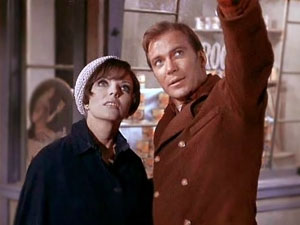 I’ve been waiting for “The City on the Edge of Forever”. If there’s one episode that even non-Star Trek fans should watch, this is the one. It’s often held up as the best episode of the series, and it’s hard to argue otherwise. It won a Hugo award for Best Dramatic Presentation (an honour shared with “The Menagerie“) and a Writers Guild of America Award for Best Written Dramatic Episode, making it the most honoured episode of all time. I know the story back to front, but watching it again you can’t help being reminded why this is such a good episode.
I’ve been waiting for “The City on the Edge of Forever”. If there’s one episode that even non-Star Trek fans should watch, this is the one. It’s often held up as the best episode of the series, and it’s hard to argue otherwise. It won a Hugo award for Best Dramatic Presentation (an honour shared with “The Menagerie“) and a Writers Guild of America Award for Best Written Dramatic Episode, making it the most honoured episode of all time. I know the story back to front, but watching it again you can’t help being reminded why this is such a good episode.
It starts with the Enterprise in orbit about a planet, from which is emanating mysterious “ripples in time”. Seeing this right after “The Alternative Factor“, you may feel this bodes ill, given how rambling and plot-holey that episode was after a similar start. A shudder rocks the ship and Sulu collapses after a giant spark leaps from the helm. One wonders why they don’t install simple circuit-breakers to prevent such things. McCoy races to the bridge and gives Sulu an injection of cordrazine to stabilise him. McCoy is putting the hypo away when the ship shudders again, and he falls on the hypo, accidentally injecting the whole contents into himself. He suddenly yells in a drug-induced craze, “Murderers!” and races violently from the bridge.
Kirk asks what the effects of an overdose of cordrazine are and learns they include crazed paranoia. We see McCoy enter the transporter room, where the transporter chief for some reason doesn’t turn to see who has walked in the door, and McCoy knocks him out then beams himself down to the planet. Kirk mobilises a landing party to capture McCoy, including Scotty and Uhura for some imponderable reason. They find him amidst some weird alien ruins and Spock gives him a nerve pinch to subdue him.
Spock notes that the time ripples are coming from a strange arch, which suddenly speaks to them, stating it is the Guardian of Forever, and that, “Since before your sun burned hot in space and before your race was born, I have awaited a question.” It begins showing them images of Earth’s history, which appear within the arch shape. These images prove that the Earth was black and white in the past. Spock starts recording the images on his tricorder. McCoy regains consciousness and bolts, leaping through the arch… and into the past. Uhura says she’s lost contact with the Enterprise, and the Guardian explains that McCoy has changed history – the Enterprise no longer exists!
Kirk and Spock come up with a plan – they will leap into the past, arriving a week or so before McCoy (they can’t pinpoint where he went more precisely) and prevent whatever he does to change history. They arrive in New York in 1930, during the Great Depression. They steal clothes and run from a cop, hiding in a basement where they are found by social worker Edith Keeler. She offers them a job and finds them a place to sleep.
Kirk is smitten with Keeler’s far-sighted visionary outlook and a romance develops over the next few days as Spock builds an electronic interface for his tricorder so they can see some of its recorded images and get an idea of what change in history McCoy might cause. The electronic equipment includes radio tubes and, for some reason, a Jacob’s ladder. One can’t help wondering why a device as futuristic and sophisticated as a tricorder doesn’t have a built-in screen… it seems less capable than an iPhone. Spock eventually perfects his tricorder interface, and discovers that Edith Keeler is the pivot point in history. She either dies soon, in 1930, or goes on to become nationally important and meet with President Roosevelt in an advisory role. Kirk guesses that, in his crazed state, perhaps McCoy kills her. Spock speculates that perhaps he saves her, and that she is meant to die.
In one of the many memorable scenes, Kirk accompanies Edith for a walk at night. She senses he is troubled and asks to “let me help.” Kirk says those words will be written in a hundred years time by a poet from a planet orbiting the leftmost star in Orion’s belt, and points up into the sky (see image above). This is a beautiful scene, spoiled only by the next shot – a stock shot of New York city at night… with an overcast sky.
A bit later, McCoy appears in the city and, after a mishap with a street bum who steals his phaser, stumbles into Keeler’s mission, where she gives him a bed for the night. Meanwhile, Spock tinkers more with the tricorder interface. When Kirk returns, he displays images of what will happen if Edith Keeler lives. It is shocking… Keeler’s pacifist activism prevents the US from entering World War II and Hitler wins. To prevent this: Edith Keeler must die. Kirk and Spock have to stop McCoy from saving her life. They soon bump into McCoy (now recovered from his drug overdose), and…
Having rescued the past, the Guardian spits them all back out where Scotty and Uhura are waiting. The Enterprise has returned. Kirk says the the best closing line of any episode, “Let’s get the hell out of here.”
There’s so much more to this episode that I can’t convey. It’s still immensely powerful. Cannot be recommended enough.
Tropes: Cool Gate, Time Abyss, Portal To The Past, Butterfly Of Doom, Set Right What Once Went Wrong, Costumer, Changed My Jumper, Good Samaritan, Mad Scientist Laboratory, Technology Marches On, Zeerust, Not Quite The Right Thing, Retroactive Precognition, Fish Out Of Temporal Water, I Just Shot Marvin In The Face, Born In The Wrong Century, Godwin’s Law Of Time Travel, Save This Person Save The World (inverted), Geeky Turn On, Temporary Love Interest, Gadgeteer Genius, Bamboo Technology, I’m A Doctor, Not A Placeholder, Look Both Ways, Bittersweet Ending.
Body count: One bum (accidentally self disintegrated), Edith Keeler.
(Image © 1966 Paramount Studios, used under Fair Use.)

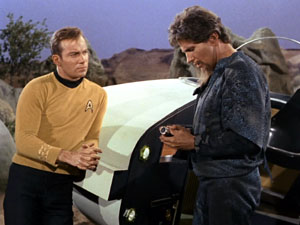 “
“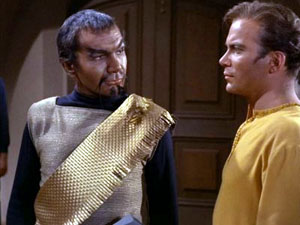 “
“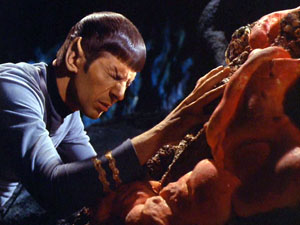 “
“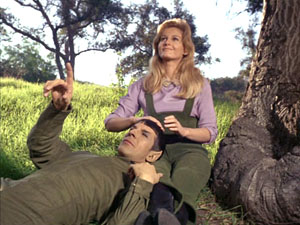 “
“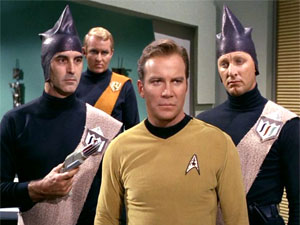 “
“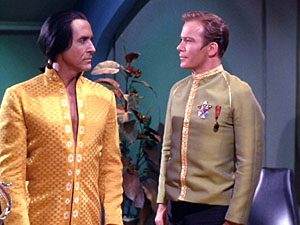 Ah… “
Ah… “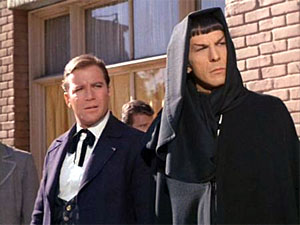 “
“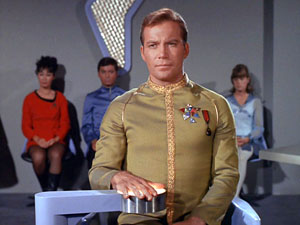 “
“